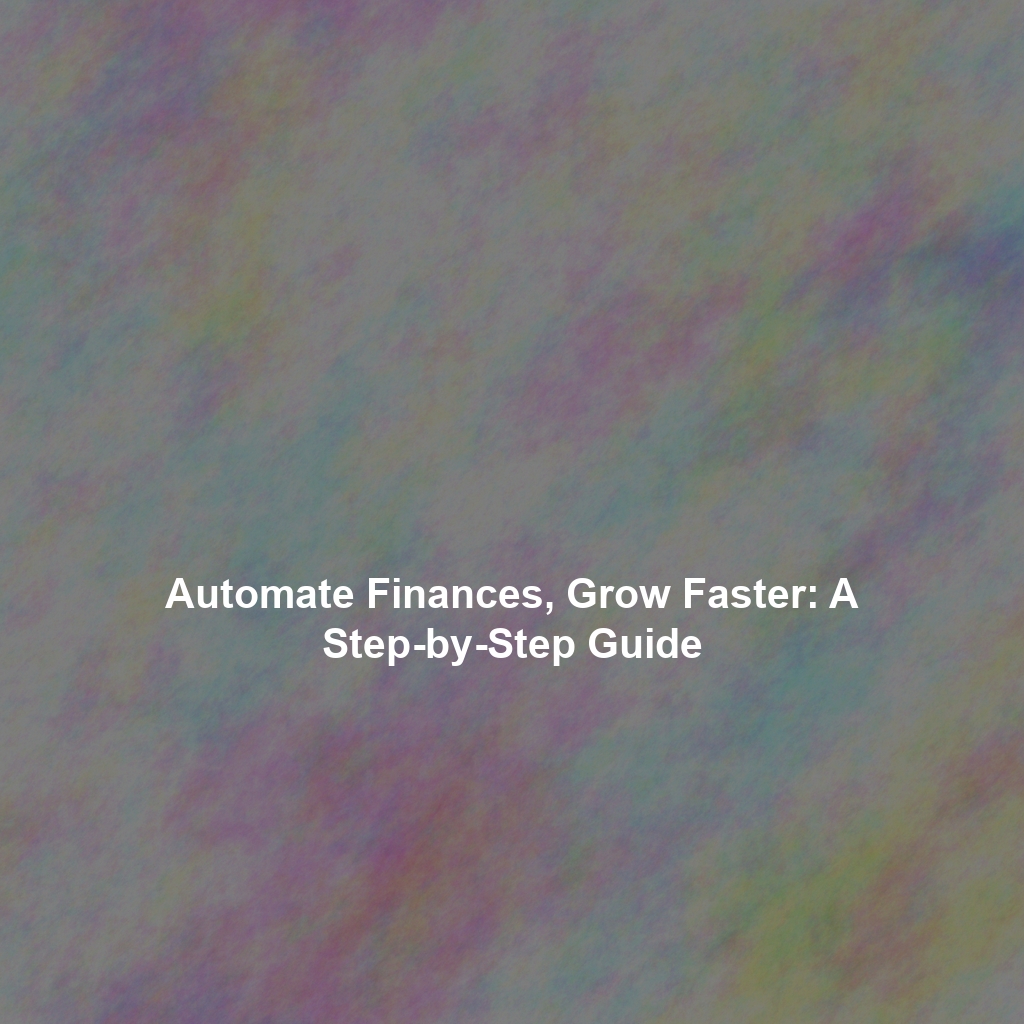For many businesses, especially startups and small to medium-sized enterprises (SMEs), the journey often begins with spreadsheets. These familiar tools are readily available and seemingly cost-effective for managing finances. However, as a business scales, relying on spreadsheets for crucial financial processes becomes increasingly cumbersome, error-prone, and ultimately, a barrier to exponential growth. This article explores how automating financial processes like invoicing, expense tracking, and financial reporting can unlock significant benefits, freeing up resources, improving accuracy, and fueling expansion.
The Spreadsheet Struggle: A Common Starting Point, A Limited Future
Let’s be honest: many of us have been there. I recall a client, a rapidly growing e-commerce company, who was using a complex network of interconnected spreadsheets to manage their inventory, sales, and expenses. While initially manageable, the system quickly became unwieldy as their sales volume increased. Formulas broke, data was duplicated, and reconciling monthly financials became a week-long nightmare. They were essentially flying blind, unable to make informed decisions based on accurate, real-time data. This is a typical scenario and highlights the limitations of relying on spreadsheets for financial management at scale.
Why Spreadsheets Fail Growing Businesses:
- Error-Prone: Manual data entry is a breeding ground for mistakes. Even a small typo can have significant financial consequences.
- Time-Consuming: Manually updating and reconciling spreadsheets takes up valuable time that could be better spent on strategic activities.
- Lack of Real-Time Visibility: Spreadsheets offer a static snapshot of data. They don’t provide the real-time insights needed to make agile business decisions.
- Collaboration Challenges: Sharing and collaborating on spreadsheets can be difficult, leading to version control issues and data inconsistencies.
- Security Risks: Spreadsheets are vulnerable to data breaches and unauthorized access.
- Scalability Issues: As a business grows, the complexity of spreadsheets increases exponentially, making them difficult to manage and maintain.
Key Insight: While spreadsheets are useful for basic tasks, they are not a sustainable solution for managing finances in a growing business. The risks and limitations outweigh the perceived cost savings.
The Power of Automation: Unlocking Efficiency and Accuracy
Automating financial processes involves using software and technology to streamline repetitive tasks, reduce manual effort, and improve accuracy. This not only frees up valuable time for finance teams but also provides real-time insights that can drive better decision-making and fuel business growth.
Key Financial Processes Ripe for Automation:
- Invoicing: Automating invoice creation, sending, and tracking can significantly reduce the time spent on accounts receivable and improve cash flow.
- Expense Tracking: Implementing automated expense tracking systems simplifies expense reporting, reduces errors, and provides better visibility into spending patterns.
- Financial Reporting: Automating financial reporting eliminates the need for manual data aggregation and manipulation, providing accurate and timely reports for informed decision-making.
- Bank Reconciliation: Automating bank reconciliation streamlines the process of matching bank statements with internal records, reducing errors and saving time.
- Payroll Processing: Automating payroll ensures accurate and timely payments to employees, while also simplifying tax compliance.
- Budgeting and Forecasting: Automating budgeting and forecasting allows for more accurate predictions and better financial planning.
Benefits of Automating Financial Processes
The benefits of automating financial processes are numerous and can have a profound impact on a business’s bottom line and overall growth trajectory.
Quantifiable Advantages:
- Increased Efficiency: Automating repetitive tasks frees up finance teams to focus on higher-value activities, such as strategic planning and analysis.
- Improved Accuracy: Automation reduces the risk of human error, leading to more accurate financial data and reporting.
- Reduced Costs: By streamlining processes and reducing manual effort, automation can significantly reduce operational costs.
- Enhanced Cash Flow: Automating invoicing and payment reminders can help improve cash flow by accelerating the collection of receivables.
- Better Decision-Making: Real-time access to accurate financial data empowers businesses to make informed decisions based on facts, not guesswork.
- Improved Compliance: Automation can help businesses stay compliant with financial regulations by ensuring accurate record-keeping and reporting.
- Scalability: Automated systems can easily scale to accommodate business growth, without requiring significant manual effort.
Key Insight: A recent study by McKinsey found that businesses that automate their financial processes can reduce their costs by up to 40% and improve their efficiency by up to 30%.
Choosing the Right Automation Tools and Platforms
Selecting the right automation tools and platforms is crucial for success. The best solution will depend on the specific needs of the business, its size, industry, and budget. Here’s a comparison of different options for various business scenarios:
For Startups and Small Businesses:
- QuickBooks Online: A popular accounting software platform that offers a range of automation features, including invoicing, expense tracking, and bank reconciliation. It’s relatively affordable and easy to use, making it a good option for startups and small businesses.
- Xero: Another popular accounting software platform that offers similar features to QuickBooks Online. It’s known for its user-friendly interface and robust reporting capabilities.
- Zoho Books: Part of the Zoho suite of business applications, Zoho Books offers a comprehensive accounting solution with strong automation capabilities. It’s a good option for businesses that already use other Zoho products.
- FreshBooks: A cloud-based accounting software designed specifically for freelancers and small businesses. It focuses on invoicing, time tracking, and expense management.
For Medium-Sized Businesses:
- NetSuite: A comprehensive cloud-based ERP (Enterprise Resource Planning) system that offers a wide range of modules, including financial management, CRM, and supply chain management. It’s a good option for medium-sized businesses that need a fully integrated solution.
- Sage Intacct: A cloud-based financial management system that offers advanced features such as multi-entity accounting, project accounting, and subscription billing. It’s a good option for businesses with complex financial needs.
- Microsoft Dynamics 365 Finance: Part of the Microsoft Dynamics 365 suite, this solution offers a comprehensive set of financial management capabilities. It integrates seamlessly with other Microsoft products.
For Large Enterprises:
- SAP S/4HANA Finance: A leading ERP system that offers a comprehensive suite of financial management capabilities. It’s a good option for large enterprises with complex financial needs and global operations.
- Oracle Financials Cloud: Another leading ERP system that offers a wide range of financial management modules. It’s known for its scalability and flexibility.
Specific Task Automation Tools:
- Bill.com: Automates accounts payable processes, including invoice processing, payment approvals, and vendor management.
- Stampli: Another accounts payable automation platform that offers AI-powered invoice processing and automated approvals.
- Gusto: Automates payroll processing, tax filing, and employee benefits administration.
- Expensify: Automates expense reporting and reimbursement.
Key Insight: When evaluating automation tools, consider factors such as ease of use, integration capabilities, scalability, security, and cost. It’s often beneficial to try out free trials or demos before making a decision.
Real-World Examples of Successful Automation
Let’s look at a few examples of how businesses have successfully leveraged automation to drive growth:
- E-commerce Company: An online retailer implemented automated invoicing and payment reminders, resulting in a 30% reduction in outstanding invoices and a significant improvement in cash flow. This allowed them to reinvest in marketing and inventory, fueling further growth.
- Professional Services Firm: A consulting firm automated its expense tracking process, eliminating manual data entry and reducing errors. This saved them valuable time and improved the accuracy of their financial reporting. They were able to dedicate more resources to client projects, boosting revenue.
- Manufacturing Company: A manufacturing company implemented a cloud-based ERP system to automate its financial management, supply chain management, and production planning. This improved efficiency, reduced costs, and provided better visibility into their operations. They could scale output to satisfy demand without proportionately scaling the finance department.
Personally, I helped a small architecture firm transition from manually tracking project budgets in spreadsheets to using a project accounting module within their accounting software. The result was a dramatic improvement in their ability to monitor project profitability in real-time, allowing them to identify and address potential cost overruns early on. This saved them thousands of dollars and improved their overall financial performance.
Compliance and Security Considerations
When automating financial processes, it’s essential to prioritize compliance and security. Businesses must ensure that their systems and processes comply with relevant financial regulations, such as GDPR, SOX, and industry-specific requirements.
Key Considerations:
- Data Security: Implement robust security measures to protect sensitive financial data from unauthorized access and cyber threats. This includes using strong passwords, encrypting data, and implementing access controls.
- Compliance with Regulations: Ensure that your automation tools and processes comply with all relevant financial regulations. This may involve working with a compliance expert to ensure that your systems meet the required standards.
- Data Privacy: Comply with data privacy regulations, such as GDPR, when collecting and processing personal financial data. This includes obtaining consent, providing transparency, and ensuring data security.
- Internal Controls: Establish strong internal controls to prevent fraud and errors. This includes segregating duties, implementing approval processes, and conducting regular audits.
- Disaster Recovery: Develop a disaster recovery plan to ensure that your financial data can be recovered in the event of a system failure or natural disaster. This includes backing up data regularly and testing the recovery process.
- Vendor Due Diligence: When selecting automation tools and platforms, conduct thorough due diligence to ensure that the vendor has adequate security and compliance measures in place. Look for certifications such as SOC 2.
Tips for Successful Automation Implementation
Implementing automation can be a complex process, but following these tips can increase the chances of success:
- Start Small: Don’t try to automate everything at once. Start with a small, manageable project and gradually expand the scope of automation.
- Identify Key Pain Points: Focus on automating the processes that are causing the most pain or inefficiencies.
- Involve Stakeholders: Involve all relevant stakeholders in the planning and implementation process. This will ensure that the automation solution meets their needs and that they are invested in its success.
- Provide Training: Provide adequate training to employees on how to use the new automation tools and processes.
- Monitor and Evaluate: Continuously monitor and evaluate the performance of the automation solution to identify areas for improvement.
- Document Everything: Document all automation processes and procedures to ensure consistency and facilitate troubleshooting.
- Seek Expert Advice: Don’t hesitate to seek expert advice from consultants or vendors who have experience implementing automation solutions.
Key Insight: Successful automation requires a clear understanding of business needs, careful planning, and a commitment to continuous improvement.
The Future of Financial Automation
The future of financial automation is bright. As technology continues to evolve, we can expect to see even more sophisticated automation solutions emerge. Artificial intelligence (AI) and machine learning (ML) are already playing a significant role in financial automation, and their influence will only continue to grow.
Emerging Trends:
- AI-Powered Automation: AI and ML are being used to automate more complex tasks, such as fraud detection, risk management, and financial forecasting.
- Robotic Process Automation (RPA): RPA is being used to automate repetitive, rule-based tasks that are currently performed by humans.
- Blockchain Technology: Blockchain is being used to improve the security and transparency of financial transactions.
- Cloud-Based Solutions: Cloud-based financial management systems are becoming increasingly popular due to their scalability, flexibility, and accessibility.
Conclusion: Embrace Automation for Exponential Growth
In today’s competitive business environment, automating financial processes is no longer a luxury but a necessity for exponential growth. By freeing up resources, improving accuracy, and providing real-time insights, automation empowers businesses to make better decisions, improve their bottom line, and scale their operations effectively. Moving from spreadsheets to automated systems is a strategic investment that can unlock significant benefits and propel your business towards sustainable success. The key is to carefully assess your needs, choose the right tools, and implement a well-planned automation strategy. Don’t let outdated processes hold you back; embrace automation and unlock your business’s full potential.
This article was optimized and published by Content Hurricane.


